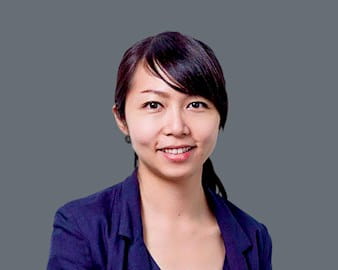
From rebranding a classic to ironing out the supply chain to optimizing morning coffee runs, these three leaders in food and beverage share where they saw opportunities to make an impact.
- By
- October 10, 2019
- Innovation

BY DEBBIE CARLSON
Carolyn Braff, ’13, Gatorade Director of Brand Marketing, Chicago

The Challenge: Since 1965, Gatorade has been the go-to sports drink for athletes. But 50 years in, sports have evolved. Customer research in 2017 revealed an opportunity to provide beverage solutions to athletes when they are off the field as well.
“Gatorade had never created a product designed for the off-the-field athlete, and we were unsure if our current brand could successfully take us there,” said Carolyn Braff, Gatorade director of brand marketing. How could Gatorade create a product geared to a different usage occasion without suggesting the original core product was inferior?
The Strategy: The team uncovered an opportunity to create a foundation for a larger category of sports drinks. The new product would complement what Gatorade always stood for—scientifically proven functional hydration—but would appeal to the needs of a nutritionally discerning consumer who wanted “clean,” or more natural, offerings.
Creating a product that could launch an entirely differentiated category required a cross-functional team. There was some internal resistance, Braff said, since it was a complete change in mind-set from the normal process of launching a new product. She reframed the problem as a new way to look at consumption categories, rather than simply thinking about a product for inactive consumption. To get buy-in, Braff spent time trying to understand the trepidations of the team and listening to their concerns. She also used data to underscore the importance of this brand in Gatorade’s future business. Helping subject matter experts see the bigger picture went a long way toward driving successful ways of working as a team.
Gatorade had never created a product designed for the off-the-field athlete.
They took a two-sided approach, focusing on both the product and the market. Data showed that some consumer targets disliked the brand’s distinctive bright colors because they seemed artificial. Working with Gatorade product-development scientists, they reviewed multiple options for a natural source of electrolytes, settling on a combination of watermelon and sea salt. That flavor combination was relatively unique in the marketplace and resonated with their athlete target, but was also mainstream enough to resonate with the broader population. That would enable the idea to gain scale.
They called the new product Bolt24, using the lightning bolt logo associated with Gatorade but not the name. To underscore that this is a drink for off the field, Bolt24 launched at the ESPY awards this summer, an awards show from ESPN that recognizes sports and its impact in culture. The drink will be in select stores and online this fall, and in major retailers starting in January 2020.
The Takeaway: When taking on major projects that could reap long-term benefits for a company, consider how you are framing the opportunity. Take time to explain the importance of the project and listen to concerns so stakeholders can see the bigger picture and project leads can ask the right questions.
Matilda Ho, ’10, Founder and Managing Director of Bits x Bites, Shanghai

The Challenge: Most of the investments in China’s food system are downstream, focusing on the consumer. But bringing safe and healthy food to consumers requires investment across the supply chain. Unlike in Europe and the United States, where there is a vibrant ecosystem of investment that has a long-term view regarding the need for better food production and safety across the supply chain, in China the investment community can be short-term focused. How can an entrepreneur bring cleaner, more sustainable food choices to the nation’s growing population?
The Strategy: Matilda Ho saw the need for greater investment in China’s food supply chain when she was running an online farmers market offering sustainable groceries to Shanghai families in 2015. So in late 2016 she founded Bits x Bites, a food tech VC fund looking to invest in innovative companies across the food supply chain.
Initially she found little interest from Chinese investors who had no interest or understanding of food tech or opportunities outside of consumer-focused innovation. Those who were interested had a very short-term mind-set. “I was asked a lot: ‘How can we invest in e-commerce and have it become a unicorn in one year?’” Ho said. But she wanted to create a fund with sustainability in mind, which requires long-term thinking.
They’ll be able to leverage our insights and they’ll have access to these startups.
While searching for the right partner, she continued to research how to create her fund. She drew inspiration for Bits x Bites from similarly structured US and European funds, attending global food technology conferences to learn about their approaches. Eventually the investor of her e-commerce platform, who believed in her mission, decided to become the sole limited partner of Bits x Bites. Together they created China’s first food tech VC platform.
They now invest in 14 global companies with a strict market mandate that their solutions will be applicable for China. For example, one American company is using artificial intelligence to perfect a new flavor for China’s biggest instant-noodle company. Bits x Bites has also partnered with COFCO, marking the first time the food-focused, state-owned enterprise has collaborated with a sector-specific VC firm to advance food technology. “They’ll be able to leverage our insights and they’ll have access to these startups,” Ho said.
The Takeaway: To build a company with a long-term focus, be patient and work on finding the right partners. Don’t waste time as you search—target your fact-finding to dig deep into the challenges you seek to solve.
Randy Paris, ’18, CEO of BrewBike, Austin, Texas

The Challenge: At many coffee shops the number of options can paralyze customers as they try and choose, leading to long ordering lines and impatience from the people who know exactly what they want. Ordering coffee through online apps requires setting up an account, and pickup can be a hassle. Randy Paris was looking for a way to streamline getting his morning coffee. How could retailers give consumers a good quality product and experience where they are also able to avoid long lines?
The Strategy: Paris discovered BrewBike, a small company run by college students. The students had come up with three solutions to serve great coffee quickly on their campus. First, take a retrofitted industrial bicycle that serves only cold-brew coffee through a keg system and park it on a campus quad. Second, open a small indoor stand serving coffee, tea, and limited food options. Third, deliver wholesale coffee. By focusing on just a few high-quality, key products that can be served quickly, the company allows customers to simply grab and go. BrewBike had the concept Paris wanted—but the company lacked access to capital.
Paris joined BrewBike in January 2018, and in February he entered BrewBike’s narrow-focused food service concept to compete in the Polsky Center’s Edward L. Kaplan, ’71, New Venture Challenge, in order to seek equity funding and raise capital. “We wanted to determine if there really was a viable business concept in BrewBike and if we could make traction to get investors,” Paris said.
I am always learning about the efficacy of a reductionist strategy.
BrewBike’s initial plan was to approach colleges and universities individually to expand, but during the New Venture Challenge, they realized that was an inefficient use of operating resources. So they partnered with a food service company, allowing them to take on more markets and give them economies of scale while keeping BrewBike’s mission of quickly offering a few great products.
BrewBike won $45,000 in the finals of the 2018 NVC and in September received $800,000 in seed-round funds. In January 2019 BrewBike had two campus locations, and it expanded to four universities in August.
The Takeaway: Companies should focus on what they do well, rather than trying to be all things to all customers. “I am always learning about the efficacy of a reductionist strategy,” Paris said. “More focus and setting limitations on yourself can be the thing that enables you to produce excellence.”

Tom Jensen, ’87, went from distributing alcohol to distilling it—and explains why small-batch whiskey should be on the tip of everyone’s tongue.
Toasting the Next Generation of Craft Spirits
Microsoft’s Mary Olges, ’00, talks work-life balance, telling a story with data, and her all-in mentality.
Insights on Mentorship and Mentality
Based on the research of UChicago professor Cathryn Nagler, ClostraBio aims to create a microbiome-based treatment that could change lives.
Meet the Polsky Center Startup Taking on Food Allergies